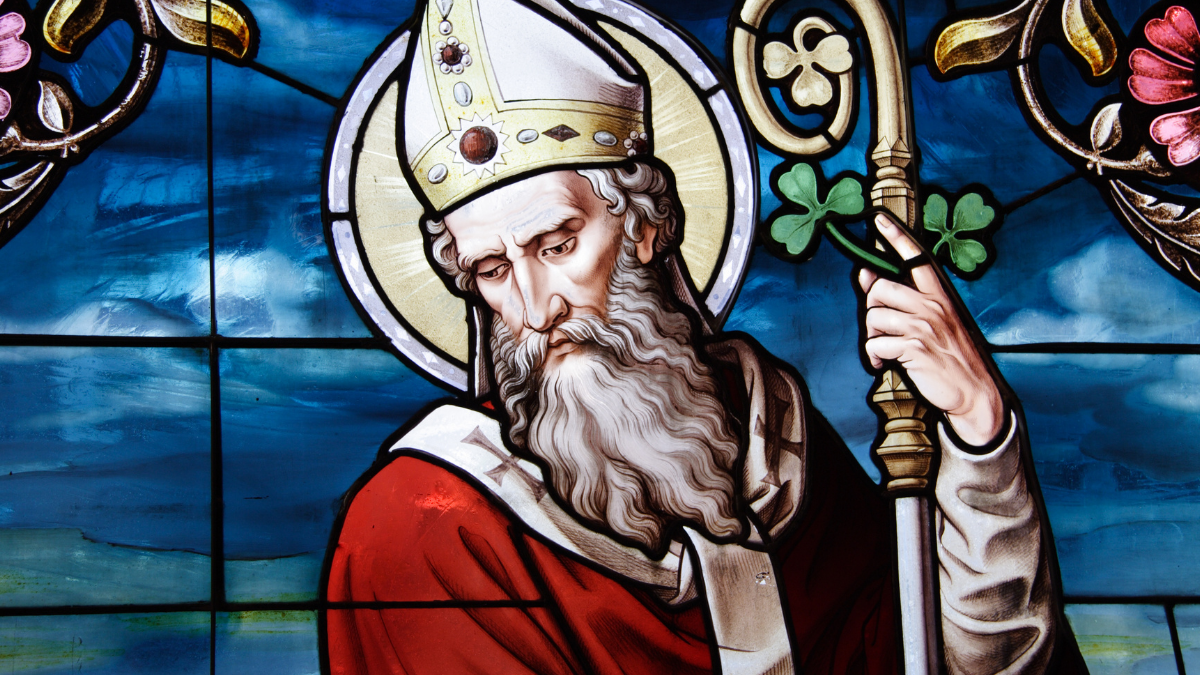Habemus Papam
Shortly after white smoke poured from the chimney above the Sistine Chapel, we were stunned to learn that the man...
May 19, 2025
March 9, 2021

When we think of Saint Patrick, our minds immediately go to the holiday, celebrated with shamrocks, meals of corned beef and cabbage, and green everywhere. Despite that immediate recognition, most of us know very little about the man himself.
Saint Patrick was born in 387 in Roman Britain. It is thought that his birth name may have been Maewyn Succat, with Patrick being a name he took on later during his religious studies. His father was a deacon from a wealthy Roman family and his mother was a close relative of Saint Martin of Tours. His grandfather was also a member of the clergy. Despite this, he was not raised with a strong emphasis on religion or education. He remarked in his memoirs, Confessio, that he was embarrassed by his lack of education.
Around the age of 16, he was captured by Irish pirates during a raiding party and taken to Ireland as a slave. While herding and tending sheep, Patrick turned to God for strength. In Ireland, a land of Celtic Druids and pagans during this time, and given the lack of focus on religion in his home growing up, it was a remarkable decision.
Patrick eventually escaped from his captivity six years later, when God told him in a dream to leave Ireland by going to the coast. It is said he walked nearly 200 miles from County Mayo to the Irish coast, where he met up with sailors to return to Britain and be reunited with his family.
Soon after returning, however, Patrick received a vision of a man from Ireland urging him to return. This vision prompted him to become a priest, and, after 15 years of studies, he was ordained by St. Germanus, the Bishop of Auxerre. He was later ordained a bishop and the successor to Ireland’s first bishop, Saint Palladius, and sent to Ireland to share the Gospel.
Patrick went to Slane, arriving in March 433. While there are many legends surrounding his time there, including the conversion of a Druid chieftain who originally wanted to kill him, we know for sure that he preached the Gospel to thousands across Ireland and began building churches across the country.
Patrick was known for his use of shamrocks, native to Ireland, to explain the Holy Trinity to the Irish. He was also said to rid Ireland of snakes, using his staff to herd them into the sea and removing from the country forever. While we don’t know for sure if either of these things are true, it is indisputable that he played a key role in converting Ireland to Christianity.
Patrick was a perfect person for the job he was in: his familiarity with the Irish language and the spiritual practices already in place in Ireland helped him connect with the Irish. He incorporated nature-oriented pagan rituals into church practices, rather than try to remove them. He celebrated Easter with bonfires, as the Irish often honored their gods with fire. He is also thought to have introduced the Celtic cross, which combined a sun, a native symbol, with the Christian cross.
He spent decades preaching and converting the Irish, despite being met with resistance. Though he accomplished much in his time in Ireland, he also endured poverty and suffering. He was imprisoned by the Druids several times, after having upset them with his teachings. He also received criticism from both the British and Irish throughout his life. Despite this, Patrick traveled extensively and supported church officials, created councils, founded monasteries, and organized Ireland into dioceses.
Saint Patrick died on March 17, 461 in Saul, Ireland, where he built the first church. He is likely buried in Down Cathedral in Down Patrick, County Down. He is now recognized as the patron saint of Ireland.
Today, Patrick is known for his humility and piety. His love, devotion, and trust in God is an example we can follow not just on St. Patrick’s Day, but all year long. Even in the most hopeless and dangerous conditions, he thought of nothing but obeying God and sharing him with any who would listen.
The poem “The Breastplate,” Is attributed to Patrick and displays his faith in the Lord:
“Christ be within me, Christ behind me, Christ before me, Christ beside me, Christ to win me, Christ to comfort and restore me, Christ beneath me, Christ above me, Christ inquired, Christ in danger, Christ in hearts of all that love me, Christ in mouth of friend and stranger.”
As we celebrate the Feast of Saint Patrick, let us strive to embody the example of both humility and courage that he showed throughout his life. In Confessio, Patrick wrote of his thankfulness that God called an unworthy sinner like him to share the Gospel. I pray you and I strive to do the same.
Shortly after white smoke poured from the chimney above the Sistine Chapel, we were stunned to learn that the man...
May 19, 2025
Join us this graduation season to pray for the young people of Mercy Home for Boys & Girls as they...
May 1, 2025
In early December we gathered around an unlit Christmas tree in our cafeteria. It was bitterly cold and dark outside!...
December 20, 2024
Comments